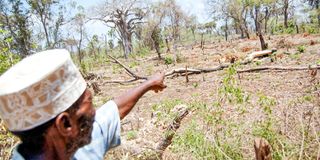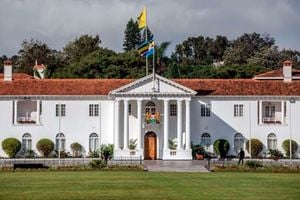Mvule, the sacred tree used in making yachts, faces extinction

A man points at massive destruction of indigenous trees including mangroves, baobab, and mvule, among others at Funzi Island in South Coast, Kenya. Illegal logging of the mvule tree driven by demand for its timber is threatening its extinction.
What you need to know:
- In West Africa, it is considered to be a sacred tree where ritual sacrifices take place underneath it and gifts are given to it for good fortune.
- Mvule yields strong and durable hardwood timber resistant to termites and used for construction, furniture, joinery, panelling, floors, boats and fuel.
- In agriculture, the tree is nitrogen-fixing. The nitrogen can be used by other trees and plants making it an ideal agroforestry tree.
- The leaves and the ashes also have medicinal uses. Its importance to the environment is significant. Studies have shown that Mvule acts as a carbon sink.
Milicia excelsa is native to tropical Africa, mostly East and West Africa. It is known as African teak in English, Iroko in Nigeria, Odum (Ghana) and Mvule (Uganda).
In West Africa, it is considered to be a sacred tree where ritual sacrifices take place underneath it and gifts are given to it for good fortune.
Petra Okeke-Bestman’s novel, The promise under the iroko tree, captures this belief in traditional Nigeria.
“It is because of the Iroko tree that the water is sweet and plentiful, the corn swells golden, the goats and chickens thrive and the trappers bring home antelopes.”
But this is doing little to protect this tree from illegal logging driven by demand for its timber in China, India and Europe.
Mvule yields strong and durable hardwood timber resistant to termites and used for construction, furniture, joinery, panelling, floors, boats and fuel.
The wood is a popular non-slip decking material on yachts, the ocean toys of the super-rich and famous.
In agriculture, the tree is nitrogen-fixing. The nitrogen can be used by other trees and plants making it an ideal agroforestry tree.
A study by Alfred Onefeli of the University of Ibadan and Agwu Onyebuchi Patrick, of Felix Houphouet- Boigny University, published in South-East European Forestry journal in 2015 confirms this.
It shows Mvule can support at least 17 other trees whose distance from it ranges from 5.4 to 10.5 metres.
These include E. guineensis (Oil palm), E. cylindricum, (Sapele mahogany), L. leucocephala (River Tamarind) and P. angolensis (African nutmeg) that are economically important and support human livelihoods.
Medicine
Its powdered bark is used to treat coughs, heart problems and fatigue. The latex is used as an anti-tumour agent and to clear stomach and throat obstructions.
The leaves and the ashes also have medicinal uses. Its importance to the environment is significant. Studies have shown that Mvule acts as a carbon sink.
That is, it converts atmospheric carbon into land carbon thus decreasing the amount of atmospheric carbon dioxide.
The tree faces a lot of pressure due to its value. According to A.B. Katende in the book Useful trees and shrubs of Uganda, Europeans started cutting Mvule in Uganda in the 1880s after they recognised the potential of its timber.
Today, the Mvule is categorised as one of the endangered timber species by the International Union for Conservation of Nature.
A number of countries, including Ghana, Ivory Coast and Mozambique, have formulated policies to protect it.
Propagation
The main form of propagation is through seeds, which cost Sh5,000 a kilogramme at the Kenya Forestry Research Institute (Kefri).
In the wild, its fruits are favoured by squirrels, bats and birds, which then disperse the seeds in their droppings.
A study in Ghana found that Mvule relies heavily on bats for seed dispersal. Over 98 per cent of the seeds falling to the ground having passed through their guts.
The seeds also germinate better than the uneaten ones and resist predation longer.
Mvule seedlings in nurseries are susceptible to blight and this explains why efforts to grow them have had limited success.
I have lost all the Mvule trees I have tried to grow in Soy over the years. But the tree is resilient and fast-growing once it reaches a certain age.
It matures in about 50 years and can be coppiced. Coppicing is a form of woodland management that exploits the capacity of trees to grow new shoots from their stumps or roots if cut down.
The new growth can be harvested after a number of years and the cycle begins anew.




